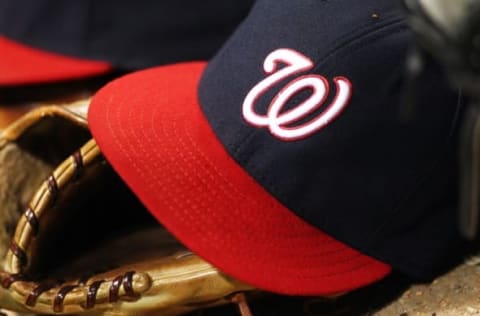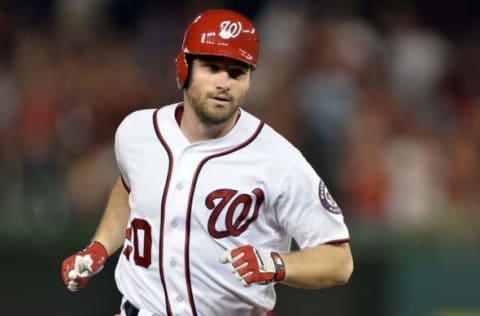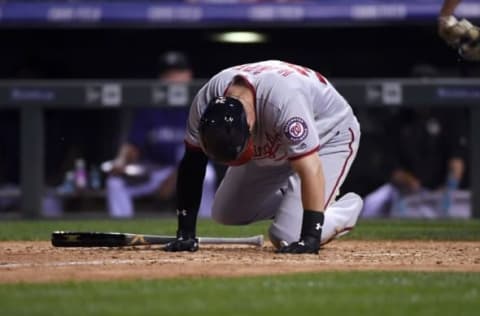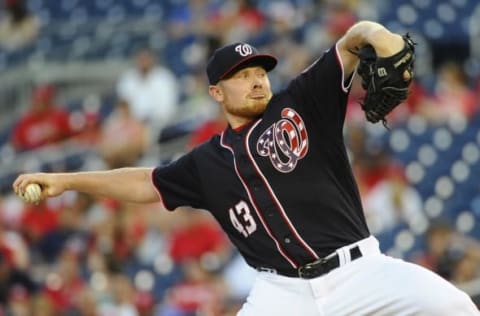Washington Nationals 2016 Season in Review


In our continuing series of season reviews, we take a closer look at the good and bad of the Washington Nationals’ 2016 campaign.
The Washington Nationals have developed something of a reputation as underachievers in recent years, one they did little to shake in the 2016 season. The Nats have finished first or second in the National League East in each of the last five years. In their past three trips to the postseason (2012, 2014, 2016) they failed to advance beyond the NL Division Series. Earlier this month, they fell to the Los Angeles Dodgers in five games in the NLDS.
This year was a case where a fine display in the regular season was soured by unfulfilled expectations in October. The Nationals completed the campaign with a 95-67 record, tied with the Texas Rangers for the second-best mark in baseball. It was a significant bounce-back from the previous year, in which a late-season collapse cost the team a playoff spot… and manager Matt Williams his job. Veteran skipper Dusty Baker took the reins, and you can’t really complain about how his squad performed from April through September.
Despite a key injury or two, this is a talented ballclub that was widely expected to go farther. This year’s version of the Dodgers were a formidable group in their own right, but look at the names on the Nationals roster and you’ll see a squad that should have at least given the Chicago Cubs a fair challenge on the road to the World Series.
The ending is still just part of the story, however. Though the tale concluded earlier than Nats fans would have liked, there was still plenty to keep them occupied and engaged over the course of 167 games. Some of it good, some of it bad, some of it in between. So let’s take a closer look at what went right this season, what went wrong, and a bit of what the Nationals are looking at heading into 2017.
Next: The Good

What Went Right?
This year’s biggest success story may have been Daniel Murphy. The Washington Nationals signed him over the offseason to a three-year, $37.5 million contact. The second baseman was a fairly coveted free agent last winter, but many debated whether his value was being unduly inflated by his herculean postseason with the New York Mets. In his previous seven years as a big leaguer, Murphy had been a rather average player.
He was anything but average in 2016. In fact, he was MVP caliber. The 31-year-old slashed a resounding .347/.390/.595 with 25 home runs and 104 RBI. He led the NL with 47 doubles, and his slugging percentage and OPS were also tops on the Senior Circuit. The only blemish on an otherwise exemplary year was the fact that Murphy missed 20 games, some of them late in September due to a strained glute. He did manage to return for the postseason, though.
If Murphy more or less maintains this level of production for two more years, his deal will be a downright bargain for the Nats.
Max Scherzer was Max Scherzer. In his second season in Washington, the 32-year-old right-hander continued to thrive as the team’s ace. He won 20 games to go along with a 2.96 ERA, 0.97 WHIP and 5.07 K/BB ratio. His win total and K/BB led the NL, as did his 228.1 innings pitched. He paced both leagues with 284 strikeouts. The highlight of his year came on May 11, when he tied the record held by Roger Clemens, Kerry Wood and Randy Johnson by striking out 20 batters in a game.
Aiding Scherzer in the rotation was a breakout season from Tanner Roark. After a forgettable 2015, the 29-year-old turned heads by posting a 2.83 ERA and 1.17 WHIP in 210 innings on the way to 16 wins. Given the continued uncertainties surrounding Stephen Strasburg, Roark’s emergence was great to see.
Another welcome sight to the Nationals’ eyes was rookie Trea Turner. The top prospect was called up for good in early July and did not look overmatched at all. In 73 games, he slashed .342/.370/.567 with 13 homers and 40 RBI. Known for his speed, Turner also imposed his will on the base paths, racking up 33 steals. Still just 23, it’s looking like the Nats have another good one for years to come.
Overall, Washington was a fairly well-rounded team, ranking eighth in runs scored (763) and second in ERA (3.51). They were more middle-of-the-pack defensively, however, ranking 14th by Fangraphs’ Defensive Rating (-0.9). This group had the ingredients for success, and it showed during the regular season.
Next: The Bad

What Went Wrong?
When it comes to the more negative aspects of the Washington Nationals’ 2016 season, it’s tempting to start with Bryce Harper. His year wasn’t “bad” as much as it was “very underwhelming.” Coming off a season in which he posted a 1.109 OPS, hit 42 home runs and won the NL MVP award, expectations were understandably through the roof for the young superstar.
The encore was startlingly tepid. Harper slashed .243/.373/.441 with 24 homers and 86 RBI. While most players wouldn’t sneeze at an .814 OPS, it still represented a sizable .295 drop-off from a year ago. He maintained his ability to draw walks (17.2 percent BB%), but pitchers were generally (and justifiably) much more careful with Harper this year and it seemed to throw him off his game at times. He also spent some time fending off injuries (shoulder, neck, thumb) throughout the year, which may have played a role in dampening his production.
Stephen Strasburg had injury issues of his own this season, including an upper back strain that knocked him out for some time in June, and a sore right elbow that effectively shut his year down in August. The righty came back for a start in early September but only made it through 2.1 frames before being forced from the game. The Nats were hoping to have him back if they made it to the NLCS, but a bullpen session reportedly didn’t go too well.
Injuries are nothing new with Strasburg, but this year’s were especially frustrating given how dominant he looked to begin the campaign. Through 17 outings, he boasted a perfect 13-0 record to go with a 2.51 ERA, 0.99 WHIP and 4.18 K/BB. Washington also put its long-term faith in Strasburg by inking him to a seven-year, $175 million extension in May, so the timing wasn’t exactly auspicious.
Continuing the injury theme, catcher Wilson Ramos tore his ACL near the end of September, ending his season and putting the kibosh on much of his offseason earning potential as an impending free agent. The Nats could have used his bat in the playoffs, as he slashed .307/.354/.496 with 22 homers and 80 RBI in 131 games during the regular season.
The NLDS went down to the wire, and unfortunately the Nationals just came out on the losing end. Three of the series’ five games (including the final two) were decided by only one run. The Nats actually outscored the Dodgers 24-19, thanks to an 8-3 victory in Game 3. After taking a 2-1 series lead following that game, Washington had two chances to put L.A. away and they just weren’t able to get it done.
Next: The Future

Now What?
So what can the Washington Nationals do to finally get over the hump and go deep into the postseason next year? For one thing, getting healthy will be a vital part of the equation. It’s a priority for most teams in the offseason, but for the Nats it holds especially true given the players affected by injury.
They will cross their fingers that Strasburg will be ready to go and is able to give them a full season’s worth of starts next year. Harper is reportedly also making good progress and should start offseason and spring activities on time. Although you never want a player to be compromised by injury, it would be a convenient explanation for the reigning MVP’s struggles this year. The Nats will hope he enters 2017 refreshed and bounces back to his earlier heights.
More from Call to the Pen
- Philadelphia Phillies, ready for a stretch run, bomb St. Louis Cardinals
- Philadelphia Phillies: The 4 players on the franchise’s Mount Rushmore
- Boston Red Sox fans should be upset over Mookie Betts’ comment
- Analyzing the Boston Red Sox trade for Dave Henderson and Spike Owen
- 2023 MLB postseason likely to have a strange look without Yankees, Red Sox, Cardinals
Washington will also need to figure out what to do at catcher. Ramos gave them great production this season and he’ll be difficult to replace. The free agent market for backstops is grim, unless you feel bullish on someone like Matt Wieters (which you probably shouldn’t). 23-year-old Pedro Severino got a look when Ramos went down (.321/.441/.607 in 34 PA) and could be given the chance to claim the job.
The closer’s role will be another matter to address. The Nats traded for Mark Melancon before the deadline and he was as good as advertised, converting 17 of 18 save opportunities for Washington to the tune of a 1.82 ERA. He’ll hit the free agent market, though, along with fellow top-of-the-line closers Aroldis Chapman and Kenley Jansen. They will all be in high demand, and it would behoove the Nationals to come away with one of them. It might make sense for them to move early on Melancon and try to lock him up before the others sign.
Next: Red Sox 2016 Season Review
There are some other questions to answer as well (where will Trea Turner play?) but for the most part a lot of the things that made the Nationals successful in 2016 will still be intact next year. That will likely be cold comfort to fans who have watched the team consistently fail to go the distance in October. This offseason will be about making adjustments and improvements where possible in hopes that next season brings the right combination of players and circumstances to go on that extended playoff run.